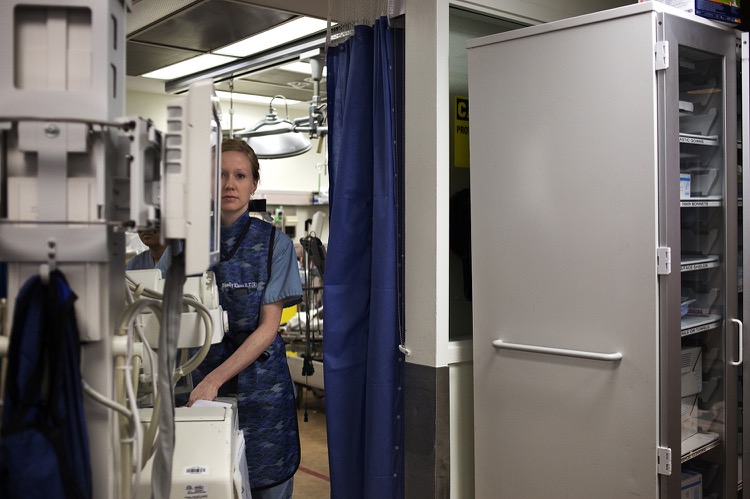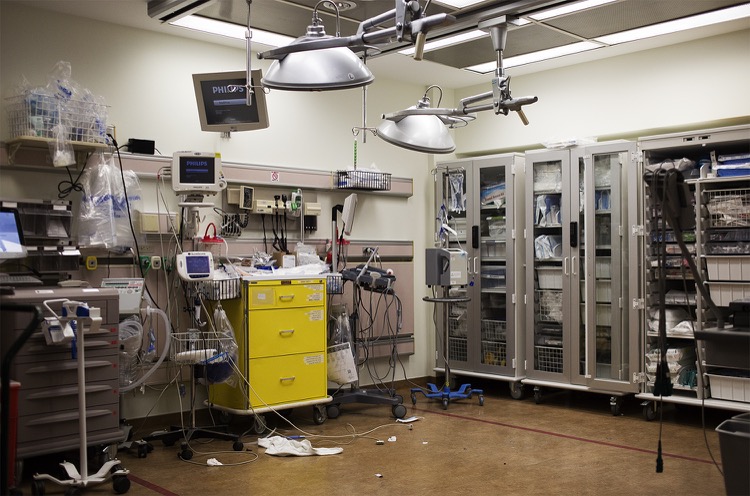‘There’s no crying when trying to resuscitate a patient’

A radiologic technologist clears a trauma bay at Saint Louis University Hospital's emergency room.

Listen to an audio version of this story
On a warm winter day, the ambulance crew of Engine House 5 took a few minutes before its next run to clean out the back of their rig.
“This call wasn’t nothing,” said emergency medical technician Nick Kuehner as he picked up discarded gauze squares and wrappings from sterile equipment.
"Trauma is a disease where recidivism happens…"
— Douglas Schuerer, trauma medical director at Barnes-Jewish
The gunshot victim they had transported from the scene of a shooting in north St. Louis had survived, and was in the care of the physicians at Saint Louis University Hospital.
But Kuehner and his partner have seen plenty of people die, too.
“If someone is shot in the head, and there’s brain matter, or if someone was shot in the heart and there’s no cardiac activity, then that would be considered obvious signs of death,” said paramedic Lorie Ledbetter, though she said she has transported fatally injured victims for safety reasons.

Patients who arrive with gunshot wounds are wheeled into a trauma bay at Saint Louis University Hospital's emergency room.
The Medical Side
The ones that might have a chance go to either Saint Louis University or Barnes-Jewish Hospital, whichever is closer. Both are Level One trauma centers, meaning they have a wide variety of specialists on call 24 hours a day. Gunshot wounds to the head and neck, or to the area covered by T-shirts and boxer shorts, get the highest level of response.
“It’s a big team that gets activated, whenever these Level Ones will go off.” said Douglas Schuerer, the trauma medical director at Barnes-Jewish. Members include;
An attending physician in the ER;
One or two residents from the emergency department;
A trauma chief and a trauma surgeon;
A second-year resident from trauma surgery;
A physician from anesthesiology;
Radiology technicians, physicians, and residents;
The staff of the operating room
Twelve months of Missouri gun violence
Not counting gun violence victims who died on the scene, 1,798 people visited Missouri hospital emergency rooms after gun-related incidents between October 2014 and September 2015, represented by the figures below. Of those,100 men and 12 women died — those figures below are red. More than half of all incidents occurred in St. Louis and St. Louis County.
Source: Missouri Hospital Association
“And that’s just the start of the initial assessment,” said Schuerer. “Certainly there are some injury patterns where we would need other specialists quickly. Fourteen or 15 people is conservative – I didn’t mention the social worker, we have a chaplain, and there’s a whole ED (emergency department) team that’s already there in terms of nursing and techs.”
From a medical standpoint, gunshots are easy, said Laurie Byrne, the chief of emergency medicine at Saint Louis University Hospital. You’re trying to find the hole and figure out what the bullet damaged. And those in the emergency room knows the job they have to do when a Level One trauma rolls up.
“You intubate or secure the patient’s airway, get blood going, making sure we have the ability to crack their chest open, and anticipating if they need to go to the operating room,” she said. “We know what we’re doing and it doesn’t stress us out.
Federal law requires that anyone who shows up at an emergency department must be stabilized and treated. For gunshot wound victims, the care comes at a price. According to data from the Missouri Hospital Association, gun-related visits to emergency departments across the state in fiscal year 2015 cost about $24 million. When a patient died, the cost was $1.6 million. National data from 2009 showed that most victims of gunshot violence were uninsured.
Despite those costs, Schuerer said, evidence suggests people are willing to support a high level of care for those who might be considered “bad guys,” as long as they understand that everyone who is seriously injured gets the same level of care.
“When they realize that if their 20-year-old was in a car accident, they would get those same resources, they’re much more likely to understand the need and want to have that in there,” he said.
The Human Side
Many of the gunshot victims treated in the city’s two emergency rooms have been there before for the same thing. But it changes nothing for everyone in the system.
"…the great thing about history, every day you have another chance to make a new one."
— Tiffany Osborn, an attending in the Barnes-Jewish ER
“This person that you transport could be someone who was involved in a robbery and just shot someone’s grandma,” said Ledbetter, the paramedic. “Or they could be someone who was at a bank and got hit in crossfire, and they’re a completely innocent person. Doesn’t matter, and we don’t know at the time.”
“I don’t look at their scars as a judgment of their past,” said Tiffany Osborn, an attending in the Barnes-Jewish ER. “It doesn’t say anything about a person’s character. And the great thing about history is that every day you have another chance to make a new one. I only look at who the person is now, and the potential of who they could be in the future.”
"…you were with people in their most vulnerable time, and it was quite an honor…"
— Tiffany Osborn
“We are not judge and jury,” said Helen Sandkuhl, a veteran ER nurse who is now the director of nursing for emergency, trauma and disaster at SLU. “In my 43 years, I never once saw a gunshot wound that was the same. And that’s the way they need to look at every patient. It’s not just another gunshot wound, but every patient is an individual.”
The emotional grind of caring for gun violence can begin to take its toll. Laurie Byrne, at SLU, said some cases make her wonder how many more gunshot victims she’ll see during her shift.
"One woman said to me, 'If I'd only prayed hard enough. It must be that I didn't pray hard enough.'"
— Tiffany Osborn
“We have had to talk to the family, and I have seen family members give the word out to avenge what happened to their loved one,” she said – a step that continues a deeply frustrating cycle.
“They come and they expect us to take care of things, and then they go back out, do the same thing and are putting themselves at risk,” Byrne said.
“I’ve never worked in a harder [emergency department,]” Sandkuhl said. “You’re not really tough, you just, you have to prepare yourself, and you have to focus on the patient, and when they said there’s no crying in baseball? There’s no crying in emergency medicine when you’re resuscitating a patient.”
"It's so confusing to me, having been in a place where violence was so completely thrust upon people…and here to have it be simply something that people do to each other…"
— Kurt Eifling, Third-year emergency medicine resident at Barnes-Jewish Hospital; Battalion surgeon, 3rd Battalion, 8th Marines, USMC
Mental-health support is available. Barnes-Jewish trains its staff to recognize compassion fatigue and understand that exposure to trauma can be just as devastating emotionally and mentally as experiencing the trauma.
But the resources aren’t used as much as they should be, Sandkuhl said. Suicide rates for both doctors and nurses are above the national average, and the data that are available for first responders show the number of suicides has gone up every year.


